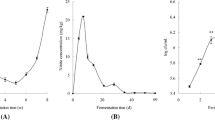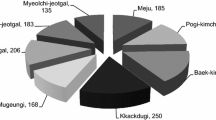Abstract
Bacterial community dynamics during soy-daddawa fermentation was investigated using culture-dependent and PCR-denaturing gradient gel electrophoresis (PCR-DGGE) molecular methods. The total titratable acidity (TTA), pH, and bacterial counts (BCs) were monitored daily during a 72-h fermentation period. Bacteria were characterized based on 16S rRNA gene sequencing. TTA ranged from 0.08 to 0.26 mg lactic acid/g, whereas pH ranged from 7.01 to 8.19. BCs increased from 3.9 to 10.61 log CFU/g. Fifty-eight isolates were obtained by culture method and clustered into seven operational taxonomic units (OTUs) at 97% sequence similarity, whereas four OTUs were obtained from the PCR-DGGE method. Taxonomic identification revealed that bacteria belonged to the genera Bacillus, Enterobacter, Enterococcus, and Staphylococcus with B. subtilis being present throughout fermentation. Medically significant isolates, including B. anthracis, Enterococcus casseliflavus, and Enterobacter hormaechei were detected. These results emphasize the need for starter culture utilization and offer a platform for starter culture screening and selection.
Similar content being viewed by others
References
Omafuvbe B, Shonukan O, Abiose S. Microbiological and biochemical changes in the traditional fermentation of soybean for “soy-daddawa”-Nigerian food condiment. Food Microbiol. 17: 469–474 (2000)
Popoola TOS, Akueshi CO. Microorganisms associated with the fermentation of soybean for the production of soybean daddawa (a condiment). Nigerian Food J. 2&3: 194–196 (1985)
Popoola TOS, Kolapo AL, Afolabi OR. Biochemical deterioration of soybean daddawa-A condiment. J. Food Agric. Environ. 5: 67–70 (2007)
Achi OK. Traditional fermented protein condiments in Nigeria. Afr. J. Biotechnol. 4: 1612–1621 (2005)
Popoola TOS, Akueshi CO. Nutritional evaluation of daddawa, a local spice made from soybean (Glycine max). Mircen J. Appl. Microb. 2: 405–409 (1986)
Ezeokoli OT, Gupta AK, Mienie C, Popoola TOS, Bezuidenhout CC. PCRdenaturing gradient gel electrophoresis analysis of microbial community in soy-daddawa, a Nigerian fermented soybean (Glycine max (L.) Merr.) condiment. Int. J. Food Microbiol. 220: 58–62 (2016)
Dakwa S, Sakyi-Dawson E, Diako C, Annan NT, Amoa-Awua WK. Effect of boiling and roasting on the fermentation of soybeans into dawadawa (soydawadawa). Int. J. Food Microbiol. 104: 69–82 (2005)
Omafuvbe BO, Abiose SH, Shonukan OO. Fermentation of soybean (Glycine max) for soy-daddawa production by starter cultures of Bacillus. Food Microbiol. 19: 561–566 (2002)
Janda JM, Abbott SL. 16S rRNA gene sequencing for bacterial identification in the diagnostic laboratory: Pluses, perils, and pitfalls. J. Clin. Microbiol. 45: 2761–2764 (2007)
Justé A, Thomma B, Lievens B. Recent advances in molecular techniques to study microbial communities in food-associated matrices and processes. Food Microbiol. 25: 745–761 (2008)
Ercolini D, Moschetti G, Blaiotta G, Coppola S. The potential of a polyphasic PCR-DGGE Approach in evaluating microbial diversity of natural whey cultures for water-buffalo mozzarella cheese production: Bias of culture-dependent and culture-independent analyses. Syst. Appl. Microbiol. 24: 610–617 (2001)
Takahashi M, Ohta T, Masaki K, Mizuno A, Goto-Yamamoto N. Evaluation of microbial diversity in sulfite-added and sulfite-free wine by culturedependent and-independent methods. J. Biosci. Bioeng. 117: 569–575 (2014)
Hamdouche Y, Guehi T, Durand N, Kedjebo KBD, Monet D, Meile JC. Dynamics of microbial ecology during cocoa fermentation and drying: Towards the identification of molecular markers. Food Control 48: 117–122 (2015)
Kim T-W, Lee J-H, Kim S-E, Park M-H, Chang HC, Kim H-Y. Analysis of microbial communities in doenjang, a Korean fermented soybean paste, using nested PCR-denaturing gradient gel electrophoresis. Int. J. Food Microbiol. 131: 265–271 (2009)
Aquilanti L, Santarelli S, Silvestri G, Osimani A, Petruzzelli A, Clementi F. The microbial ecology of a typical Italian salami during its natural fermentation. Int. J. Food Microbiol. 120: 136–145 (2007)
Oguntoyinbo FA, Tourlomousis P, Gasson MJ, Narbad A. Analysis of bacterial communities of traditional fermented West African cereal foods using culture independent methods. Int. J. Food Microbiol. 145: 205–210 (2011)
Kimaryo VM, Massawe NA, Olasupo NA, Holzapfel WH. The use of starter culture for the fermentation of cassava for the production of “Kivunde,” a traditional Tanzanian food product. Int. J. Food Microbiol. 56: 179–190 (2000)
Li J-F, Li L, Sheen J. Protocol: A rapid and economical procedure for purification of plasmid or plant DNA with diverse applications in plant biology. Plant Methods 6: 1–8 (2010)
Muyzer G, De Waal EC, Uitterlinden AG. Profiling of complex microbial populations by denaturing gradient gel electrophoresis analysis of polymerase chain reaction-amplified genes coding for 16S rRNA. Appl. Environ. Microb. 59: 695–700 (1993)
R Core Team. R Foundation for Statistical Computing, Vienna, Austria (2013)
Schloss PD, Westcott SL, Ryabin T, Hall JR, Hartmann M, Hollister EB, Lesniewski RA, Oakley BB, Parks DH, Robinson CJ, Sahl JW, Stres B, Thallinger GG, Van Horn DJ, Weber CF. Introducing mothur: Open-source, platformindependent, community-supported software for describing and comparing microbial communities. Appl. Environ. Microb. 75: 7537–7541 (2009)
Larkin MA, Blackshields G, Brown NP, Chenna R, McGettigan PA, McWilliam H, Valentin F, Wallace IM, Wilm A, Lopez R, Thompson JD, Gibson TJ, Higgins DG. Clustal W and Clustal X version 2.0. Bioinformatics 23: 2947–2948 (2007)
Xia X. DAMBE5: A comprehensive software package for data analysis in molecuar biology and evolution. Mol. Biol. Evol. 30: 1720–1728 (2013)
Tamura K, Stecher G, Peterson D, Filipski A, Kumar S. MEGA6: Molecular Evolutionary Genetics Analysis version 6.0. Mol. Biol. Evol. 30: 2725–2729 (2013)
Parkouda C, Nielsen DS, Azokpota P, Ivette Irène Ouoba L, Amoa-Awua WK, Thorsen L, Hounhouigan JD, Jensen JS, Tano-Debrah K, Diawara B, Jakobsen M. The microbiology of alkaline-fermentation of indigenous seeds used as food condiments in Africa and Asia. Crit. Rev. Microbiol. 35: 139–156 (2009)
Sauer M, Porro D, Mattanovich D, Branduandi P. Microbial production of organic acids: Expanding the markets. Trends Biotechnol. 25: 100–108 (2008)
Sarkar P, Cook P, Owens J. Bacillus fermentation of soybeans. World J. Microb. Biot. 9: 295–299 (1993)
Terlabie NN, Sakyi-Dawson E, Amoa-Awua WK. The comparative ability of four isolates of Bacillus subtilis to ferment soybeans into dawadawa. Int. J. Food Microbiol. 106: 145–152 (2006)
Adewumi GA, Oguntoyinbo FA, Keisam S, Romi W, Jeyaram K. Combination of culture-independent and culture-dependent molecular methods for the determination of bacterial community of iru, a fermented Parkia biglobosa seeds. Front. Microbiol. 3: 1–9 (2013)
Iwuoha CI, Eke OS. Nigerian indigenous fermented foods: Their traditional process operation, inherent problems, improvements and current status. Food Res. Int. 29: 527–540 (1996)
Achi OK. The potential for upgrading traditional fermented foods through biotechnology. Afr. J. Biotechnol. 4: 375–380 (2005)
Duarte S, Pascoal C, Cassio F. Denaturing Gradient Gel Electrophoresis (DGGE) in Microbial Ecology-Insights from Freshwaters. pp. 173–196. In: Gel Electrophoresis -Principles and Basics. Magdeldin S (ed). INTECH, Open Access (2012)
Wang L-T, Lee F-L, Tai C-J, Kasai H. Comparison of gyrB gene sequences, 16S rRNA gene sequences and DNA–DNA hybridization in the Bacillus subtilis group. Int. J. Syst. Evol. Micr. 57: 1846–1850 (2007)
Holzapfel WH. Appropriate starter culture technologies for small-scale fermentation in developing countries. Int. J. Food Microbiol. 75: 197–212 (2002)
Author information
Authors and Affiliations
Corresponding author
Rights and permissions
About this article
Cite this article
Ezeokoli, O., Gupta, A., Popoola, T. et al. Molecular analysis of bacterial community dynamics during the fermentation of soy-daddawa condiment. Food Sci Biotechnol 25, 1081–1086 (2016). https://doi.org/10.1007/s10068-016-0174-8
Received:
Revised:
Accepted:
Published:
Issue Date:
DOI: https://doi.org/10.1007/s10068-016-0174-8




